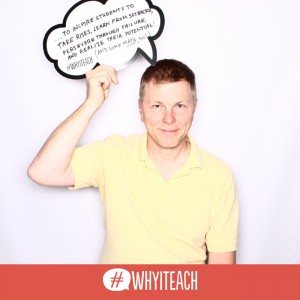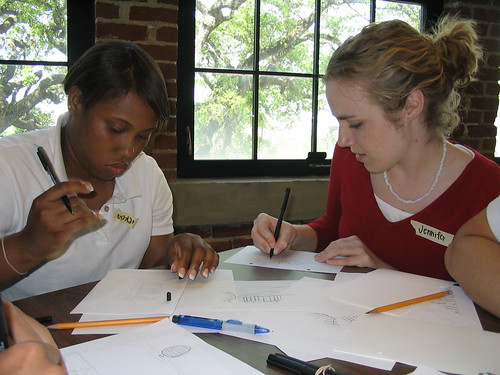On June 23rd, I receiv ed an email from The Bill and Melinda Gates Foundation inviting me to the fifth convening of Elevating and Celebrating Effective Teaching and Teachers (ECET²). I had never heard of this, and to be honest, thought the email was either a mistake or a hoax. What, I asked myself, had I accomplished in my teaching that would make me worthy of such an invitation? I know that I have a lot of experience, but I am the kind of person and teacher that looks with awe and wonder at what others can do without giving my own work much credit. After three intense days with the ECET2 community,that is now changed!
ed an email from The Bill and Melinda Gates Foundation inviting me to the fifth convening of Elevating and Celebrating Effective Teaching and Teachers (ECET²). I had never heard of this, and to be honest, thought the email was either a mistake or a hoax. What, I asked myself, had I accomplished in my teaching that would make me worthy of such an invitation? I know that I have a lot of experience, but I am the kind of person and teacher that looks with awe and wonder at what others can do without giving my own work much credit. After three intense days with the ECET2 community,that is now changed!
The goal of the convening is to “celebrate effective teachers and to build a strong network of teacher leaders working together to elevate the practice and profession”, and the experience did not disappoint. I was led to think of myself at various points as a superhero, a time-traveler, and someone who makes a difference in kids’ lives. We were treated like royalty, and that was something that does not happen very often. You see, it is easy to get dragged down by the frustration of struggling students, failed lessons, unhappy parents, and the pressure everyone feels about college admissions and opportunities. ECET2 showed me to flip the script, and start thinking of the lives of the students first.
One of the powerful lessons was “lead with love”; show students how much I care about them, and that act alone will pave the way to powerful learning! I heard amazing stories of why other teachers were drawn to the profession through short keynote “cultivating a calling” speeches. All were inspiring; one such speech was delivered entirely in sign language by Lauren Maucere. She advocated for the needs of her students in the deaf community to learn in a way that serves their needs best. Lauren stood on stage and signed her message, while it was interpreted for the hearing community in a powerful flip of the usual delivery. The room of 500-plus was pin-drop quiet, and all eyes were on Lauren. Thanks to her, I will never forget how important it is to advocate for my students.
There were excellent breakout sessions as well, where I learned other teacher’s perspectives on promoting student self-monitoring, developing my teacher-leader voice, and developing individual and team goals for mathematics instruction using data and rubrics. These sessions were presented by teachers, and represented success stories for the presenters. However, each session also sought to leave us with practical takeaways, and helped me see not only how I can improve in those areas, but also to celebrate what I already knew by sharing with others. There was no greater feeling than sharing an idea in the presence of so many accomplished educators and receiving a ‘shout out!’ in return. (Stay tuned for upcoming post on developing students’ self-monitoring.)
The most compelling part of the entire experience was the Colleague Circle. All of the participants were organized ahead of time into groups of 8 or 9, led by a member of ECET2’s trained volunteers. Ours, led by Derek Long, consisted of teachers from all over the country (Florida, Tennessee, Washington (state), Washington, D.C., to name a few) and varied experience levels. The goal was to connect us in professional problem solving to find solutions to problems of practice. We wrote down what was on our minds, and then as a group chose two problems to address. The process was well-defined, and designed to give the person whose problem was addressed practical and actionable solutions to employ right away. This was a powerful reminder of how teachers, if put together to address problems, can bring to bear their experience and skill to impact the overall practice of teaching.
You would think that a dinner/reception at the Seattle Aquarium, complete with awesome goodies and chances to see the otters and seals would top the list of highlights, but you’d be wrong. My highlight was seeing Melinda Gates herself, who was a surprise guest at our Thursday keynote. She expressed her passion for teachers, students and the teaching profession that did not do justice to her reputation. Moreover, she spent the rest of the day circulating to breakout sessions (sadly, not mine) and speaking with teachers. I could not help but be inspired by her words and energy!
Why not celebrate? Teachers should recognize what they accomplish in their classrooms, and understand that is where the magic happens. In the recent past, I introduced myself to students and parents by stating that my 30 years of experience is just code for “I’m old”. Now, I will say that my 30-years of experience means that I am traveling farther into the future than I ever have before, by making a difference in the lives of my students!
Post Script: I was moved during this experience to participate in #thankateacher. My shout out goes to Mr. Hal Blocksom, my 4th grade Social Studies teacher (Red Clay Creek School District, Delaware). He not only made me laugh through his comedic style, but taught me that I had to work to learn. He held my feet to the fire, denying me recess to finish my country report (on Ethiopia), but praised me for my level of understanding and knowledge. I am forever in his debt.
If you are on twitter, send a shout-out today to that teacher that made a difference in your life, and helped you get where you are today.Who inspired your success? Write their name on a piece of paper, and take a selfie with it. Post with #thankateacher. You’ll be glad you did! Better yet, write an actual letter. Trust me when I tell you that your former teacher will treasure it forever. I still have letters from 30 years ago.

 ed an email from The Bill and Melinda Gates Foundation inviting me to the fifth convening of Elevating and Celebrating Effective Teaching and Teachers (ECET²). I had never heard of this, and to be honest, thought the email was either a mistake or a hoax. What, I asked myself, had I accomplished in my teaching that would make me worthy of such an invitation? I know that I have a lot of experience, but I am the kind of person and teacher that looks with awe and wonder at what others can do without giving my own work much credit. After three intense days with the ECET2 community,that is now changed!
ed an email from The Bill and Melinda Gates Foundation inviting me to the fifth convening of Elevating and Celebrating Effective Teaching and Teachers (ECET²). I had never heard of this, and to be honest, thought the email was either a mistake or a hoax. What, I asked myself, had I accomplished in my teaching that would make me worthy of such an invitation? I know that I have a lot of experience, but I am the kind of person and teacher that looks with awe and wonder at what others can do without giving my own work much credit. After three intense days with the ECET2 community,that is now changed!
